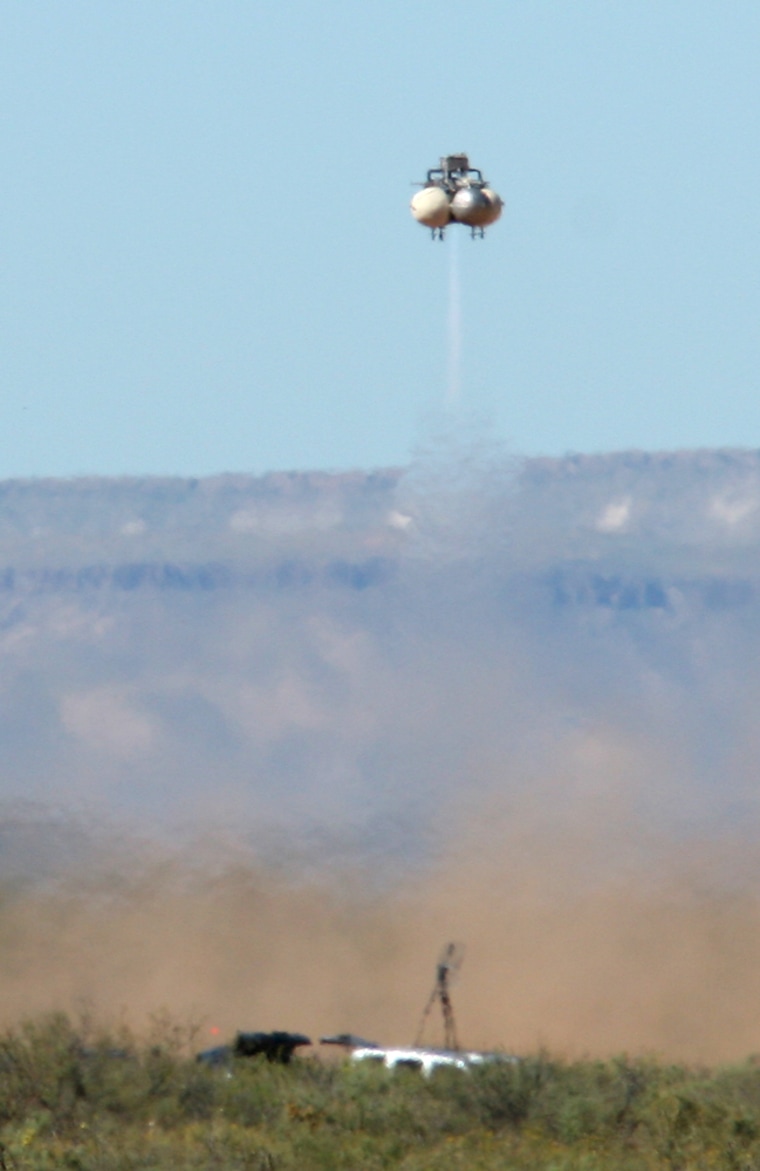LAS CRUCES, N.M. - No one won a share of the $2.4 million in NASA prizes being offered at a New Mexico rocket festival on Friday, but some of the competitors recorded new "personal bests."
On the first day of this year's Wirefly X Prize Cup, Armadillo Aerospace's lunar lander prototype rose to new heights, even though a mishap spoiled its bid to win a prize in the Northrop Grumman Lunar Lander Challenge. And one of the robot climbers in the Space Elevator Games reached the top of its tether for the first time, even though the task wasn't done quickly enough to earn a payoff.
For those teams and other competitors, the good news is that they all have a chance to try again on Saturday.
The X Prize Cup, conducted at Las Cruces International Airport, had its share of fizzles as well as fantastic blastoffs — and the impresario behind the annual event, Peter Diamandis, said even the failures taught a lesson.
"We need to tell people that failure is OK," he told the crowd. "It's OK to take risks, and some of these vehicles are taking real risks."
Pixel soars but suffers damage
One of those vehicles was Pixel, the rocket craft that Armadillo entered in the $2 million Lunar Lander Challenge. Pixel's task was to blast off under remote control from one launch pad, hang in the air for 90 seconds and rise at least 50 meters (164 feet) off the ground, then land at a second pad 100 meters (328 feet) away. Then it had to retrace its steps to return to the starting point, after an opportunity for refueling.
Doing all that successfully would earn the Armadillo team a $350,000 prize from NASA.
Pixel accomplished the first half of the task smartly, with Armadillo team leader John Carmack at the controls. As thousands of spectators cheered, Carmack guided the craft up to the required height, then over to the required landing spot. But Pixel landed a little bit harder than Carmack planned, and the feet on its legs broke off. What's more, the engine flared up with flames that burned some of the craft's circuitry.
Those problems ruled out the return trip, meaning that Armadillo could not win the $350,000.
"I was fully prepared to fly on bloody stumps back to the middle pad," Carmack said later. "But we wound up cooking a couple of wires."
Fly, fly again
Carmack said his team planned to fly again on Saturday, and after the spectators left, the Armadillo team hatched what could be a history-making plan:
- The team would try to repair Pixel, possibly using parts from Armadillo's other lander prototype, nicknamed Texel. If Pixel could not be repaired, Texel might be flown instead. In either case, another bid would be made for the $350,000 prize.
- Texel had been reserved for a more ambitious challenge - which involves 180 seconds of hang time and an uneven, moonline launch site rather than the smooth launch pad provided for Friday's bid. The prize for that feat is $1 million.
- But if Armadillo wins the $350,000 prize, the team might opt instead for a pure demonstration flight, aimed at breaking the duration record for flight by a rocket ship that takes off and lands vertically, team member Phil Eaton said. He said the current record is 142 seconds, set by the Delta Clipper in 1996.
Armadillo is the only team competing this year for the prizes. Any money that's not won - incuding $650,000 that was set aside for potential runner-up prizes - will be carried over for next year's competition.
In an e-mail, Ken Davidian, a contractor for NASA's Centennial Challenges program, said the space agency was backing the prizes "to stimulate the development of certain technologies relevant to NASA's return to the moon," as well as "to encourage the creation and success of new businesses and organizations that have proven operational expertise in the demanding technologies of interest to NASA."
Carmack said he was happy with his team's effort, noting that his landers were capable of more change in velocity, or delta-V, than the SpaceShipOne rocket plane that won the $10 million Ansari X Prize two years ago. He said Pixel and Texel were built with volunteer labor for "$200,000 or so and change." Most of the funds have been provided by Carmack, a millionaire video-game programmer.
Robot reaches the top
Over on the other side of the X Prize Cup grounds, more than a dozen teams were trying to win prizes worth a total of $400,000 in the NASA-backed Space Elevator Games. One competition requires teams to manufacture tether material that is stronger than the current standard, while another contest calls on teams to build beam-powered robotic climbers capable of making their way up a 50-meter (164-foot) tether in less than a minute.
The Space Elevator Games got their start last year in California, but this year marks the first time the competitions have been conducted at the X Prize Cup in New Mexico.
Friday's strong winds led many of the teams in the climber competition to pass up making an attempt — but the University of Michigan's team, led by Julie Bellerose, reached a milestone when its robot reached the top of the tether in six and a half minutes. No one had ever made it all the way to the top before, even though the pace was too slow to qualify for a prize.
Randy Lieberman, who leads the Spanish-sponsored Recens team in the climber competition, said this year's entries represent a significant advance over last year's. He also emphasized that his ultimate goal was to set the stage for the development of space elevators, futuristic "highways to the sky" that could theoretically drive down the cost of getting to orbit.
"The serious money really isn't in the competition," he said. "It's in making the technologies work for the elevator."
